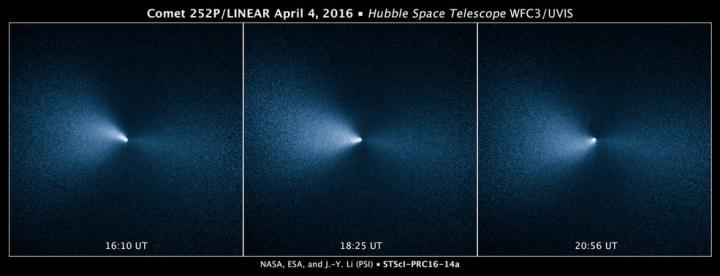Hubble catches views of a jet rotating with Comet 252P/LINEAR

Comet 252P/LINEAR is shown as it passed by Earth. Credits: NASA, ESA, and J.-Y. Li (Planetary Science Institute)
The images were taken on April 4, 2016, roughly two weeks after the icy visitor made its closest approach to Earth on March 21. The comet traveled within 3.3 million miles of Earth, or about 14 times the distance between our planet and the moon. These observations also represent the closest celestial object Hubble has observed, other than the moon.
The images reveal a narrow, well-defined jet of dust ejected by the comet's icy, fragile nucleus. The nucleus is too small for Hubble to resolve. Astronomers estimate that it is less than one mile across.
A comet produces jets of material as it travels close to the sun in its orbit. Sunlight warms ices in a comet's nucleus, resulting in large amounts of dust and gas being ejected, sometimes in the form of jets. The jet in the Hubble images is illuminated by sunlight.
The jet also appears to change direction in the images, which is evidence that the comet's nucleus is spinning. The spinning nucleus makes the jet appear to rotate like the water jet from a rotating lawn sprinkler. The images underscore the dynamics and volatility of a comet's fragile nucleus.
Comet 252P/LINEAR is traveling away from Earth and the sun; its orbit will bring it back to the inner solar system in 2021, but not anywhere close to the Earth.
These visible-light images were taken with Hubble's Wide Field Camera 3.
The Hubble Space Telescope is a project of international cooperation between NASA and the European Space Agency. NASA's Goddard Space Flight Center in Greenbelt, Maryland, manages the telescope.
The Space Telescope Science Institute (STScI) in Baltimore, Maryland, conducts Hubble science operations. STScI is operated for NASA by the Association of Universities for Research in Astronomy in Washington, D.C.
###
For images, video, and more information about Comet 252P/LINEAR and Hubble, visit:
http://hubblesite.
Donna Weaver / Ray Villard
Space Telescope Science Institute, Baltimore, Maryland
410-338-4493 / 410-338-4514
dweaver@stsci.edu / villard@stsci.edu
Jian-Yang Li
Planetary Science Institute, Tucson, Arizona
571-488-9999
jyli@psi.edu
Media Contact
All latest news from the category: Physics and Astronomy
This area deals with the fundamental laws and building blocks of nature and how they interact, the properties and the behavior of matter, and research into space and time and their structures.
innovations-report provides in-depth reports and articles on subjects such as astrophysics, laser technologies, nuclear, quantum, particle and solid-state physics, nanotechnologies, planetary research and findings (Mars, Venus) and developments related to the Hubble Telescope.
Newest articles

A universal framework for spatial biology
SpatialData is a freely accessible tool to unify and integrate data from different omics technologies accounting for spatial information, which can provide holistic insights into health and disease. Biological processes…

How complex biological processes arise
A $20 million grant from the U.S. National Science Foundation (NSF) will support the establishment and operation of the National Synthesis Center for Emergence in the Molecular and Cellular Sciences (NCEMS) at…

Airborne single-photon lidar system achieves high-resolution 3D imaging
Compact, low-power system opens doors for photon-efficient drone and satellite-based environmental monitoring and mapping. Researchers have developed a compact and lightweight single-photon airborne lidar system that can acquire high-resolution 3D…





















